 Relatives of Johnny Mutinda Musango, 48, weep after identifying his body at the city morgue in Nairobi, Kenya, on Tuesday, September 24. Musango was one of the victims of the Westgate Mall hostage siege. Kenyan security forces were still combing the mall on the fourth day of the siege by al Qaeda-linked terrorists.
Relatives of Johnny Mutinda Musango, 48, weep after identifying his body at the city morgue in Nairobi, Kenya, on Tuesday, September 24. Musango was one of the victims of the Westgate Mall hostage siege. Kenyan security forces were still combing the mall on the fourth day of the siege by al Qaeda-linked terrorists. 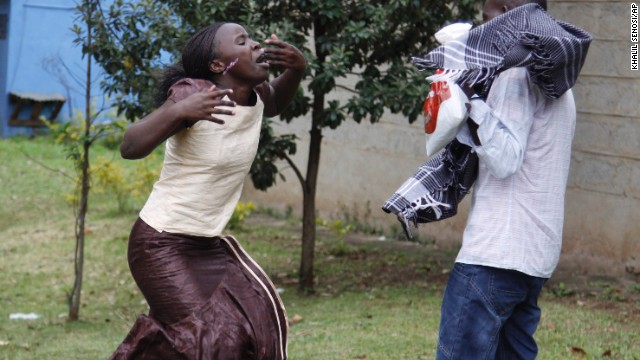 Ann Gakii reacts at the Nairobi City Mortuary after identifying the body of her father, who was killed in the mall attack on Saturday.
Ann Gakii reacts at the Nairobi City Mortuary after identifying the body of her father, who was killed in the mall attack on Saturday. 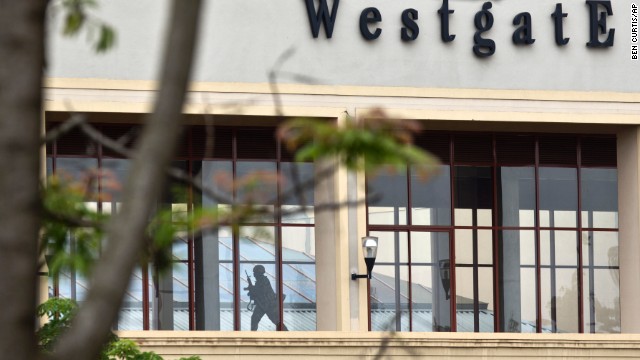 A Kenyan soldier runs through a corridor on an upper floor at the Westgate Shopping Mall in Nairobi, Kenya, on September 24, shortly before an explosion was heard. Sounds of heavy gunfire erupted from the mall Tuesday, even as authorities said they had the building under their control. But four days after Al-Shabaab terrorists stormed the swanky mall, several gunmen — including snipers — were still inside, two senior officials said.
A Kenyan soldier runs through a corridor on an upper floor at the Westgate Shopping Mall in Nairobi, Kenya, on September 24, shortly before an explosion was heard. Sounds of heavy gunfire erupted from the mall Tuesday, even as authorities said they had the building under their control. But four days after Al-Shabaab terrorists stormed the swanky mall, several gunmen — including snipers — were still inside, two senior officials said. 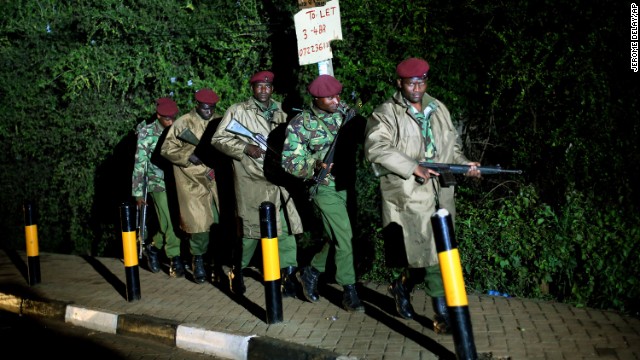 Kenyan Defense Forces walk near the mall on Monday, September 23.
Kenyan Defense Forces walk near the mall on Monday, September 23. 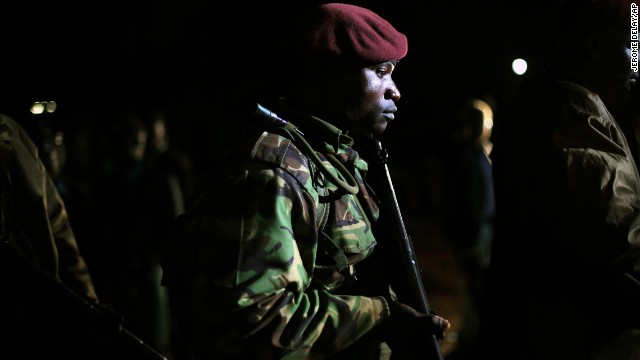 Kenyan Defense Forces leave the mall on September 23.
Kenyan Defense Forces leave the mall on September 23. 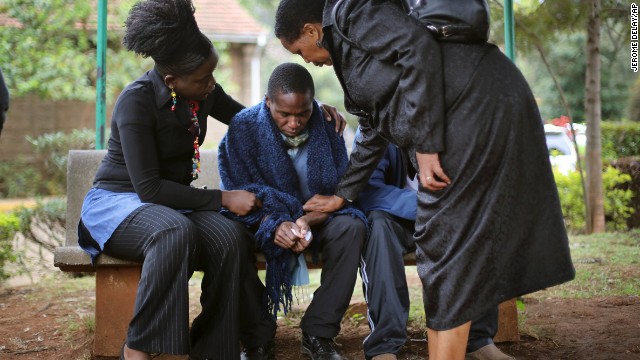 Stephen, center, is comforted by relatives as he waits for the post mortem exam of his father, who was killed in Saturday’s attack at the mall.
Stephen, center, is comforted by relatives as he waits for the post mortem exam of his father, who was killed in Saturday’s attack at the mall. 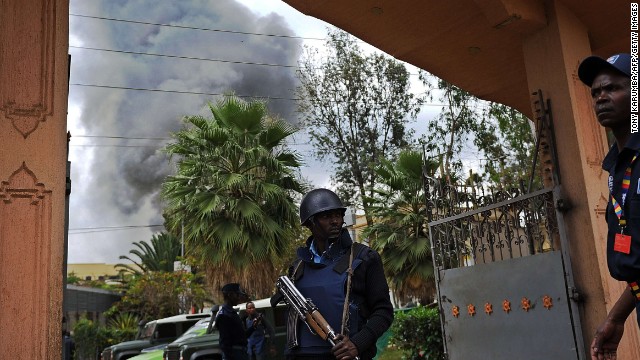 A Kenyan police officer guards the entrance of a building near the mall on September 23.
A Kenyan police officer guards the entrance of a building near the mall on September 23. 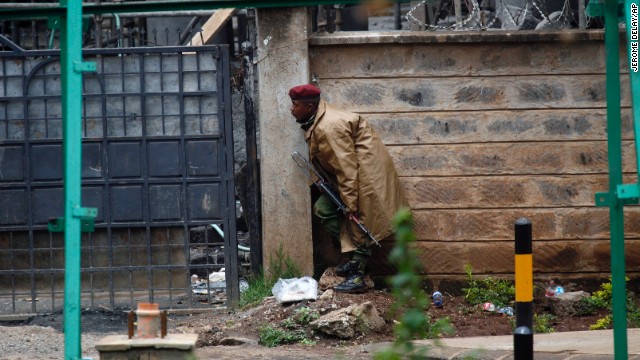 A Kenyan security officer takes cover as gunfire and explosions are heard from the mall on September 23.
A Kenyan security officer takes cover as gunfire and explosions are heard from the mall on September 23. 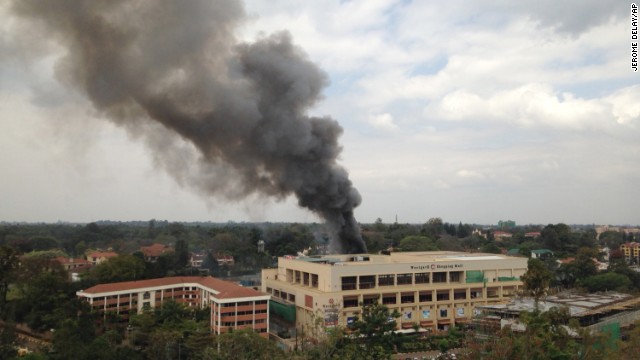 Heavy smoke rises from the Westgate Shopping Mall on September 23.
Heavy smoke rises from the Westgate Shopping Mall on September 23. 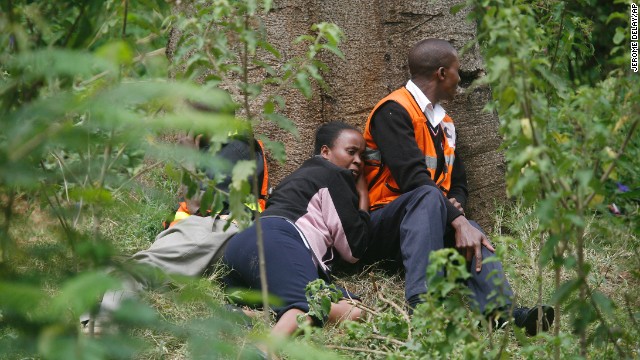 Medics take cover behind a tree as gunfire and explosions are heard from the Westgate Mall on September 23.
Medics take cover behind a tree as gunfire and explosions are heard from the Westgate Mall on September 23. 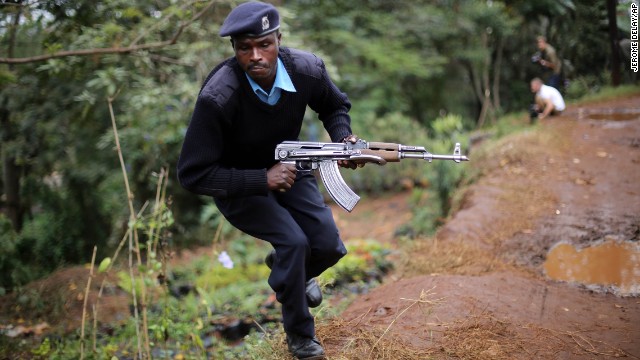 A Kenyan police security officer runs for cover as heavy smoke rises from the mall on September 23.
A Kenyan police security officer runs for cover as heavy smoke rises from the mall on September 23. 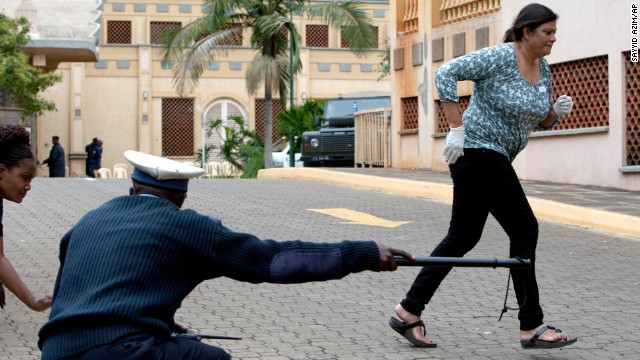 A paramedic runs for cover outside the mall on September 23.
A paramedic runs for cover outside the mall on September 23. 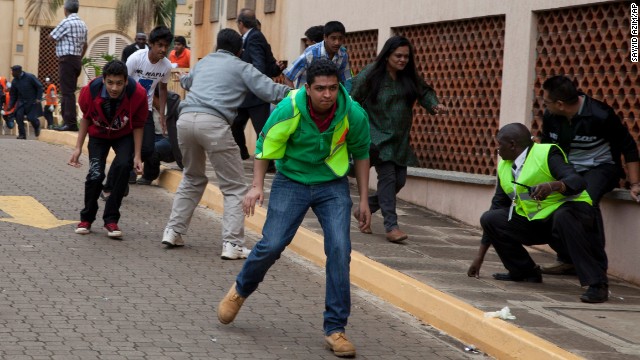 People run for cover outside the mall after heavy shooting started on September 23.
People run for cover outside the mall after heavy shooting started on September 23. 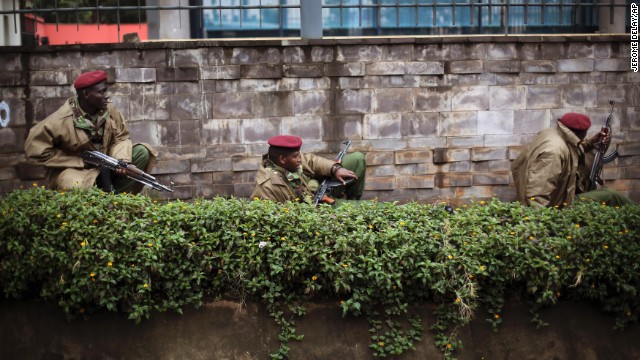 Kenyan security forces crouch behind a wall outside the mall on September 23.
Kenyan security forces crouch behind a wall outside the mall on September 23. 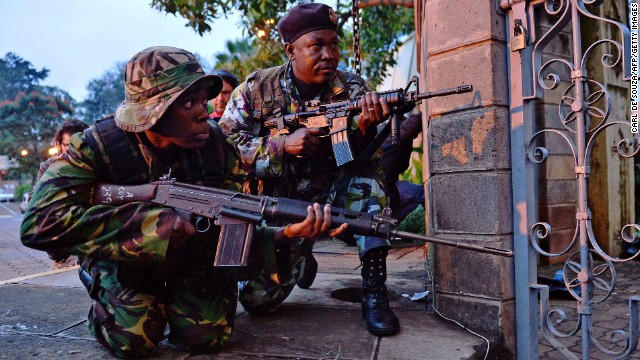 Soldiers take cover after gunfire near the mall on September 23.
Soldiers take cover after gunfire near the mall on September 23. 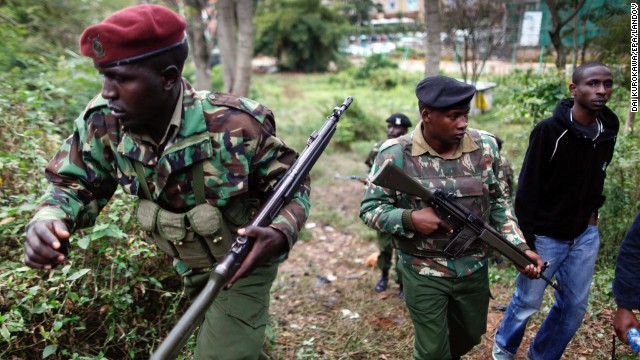 Kenyan paramilitary police officers patrol the area near the mall on Sunday, September 22.
Kenyan paramilitary police officers patrol the area near the mall on Sunday, September 22.  Soldiers from the Kenya Defense Forces arrive outside the Westgate Mall on September 22.
Soldiers from the Kenya Defense Forces arrive outside the Westgate Mall on September 22. 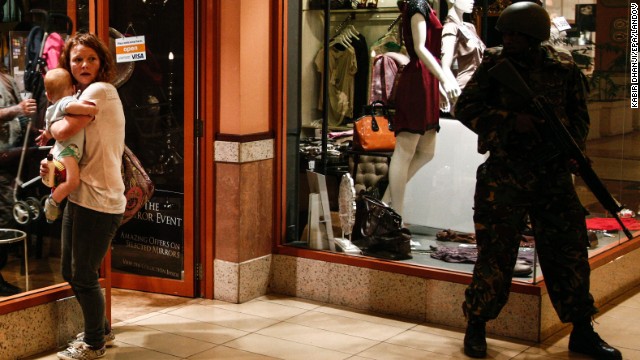 A woman shields a baby as a soldier stands guard inside the Westgate Mall on Saturday, September 21.
A woman shields a baby as a soldier stands guard inside the Westgate Mall on Saturday, September 21. 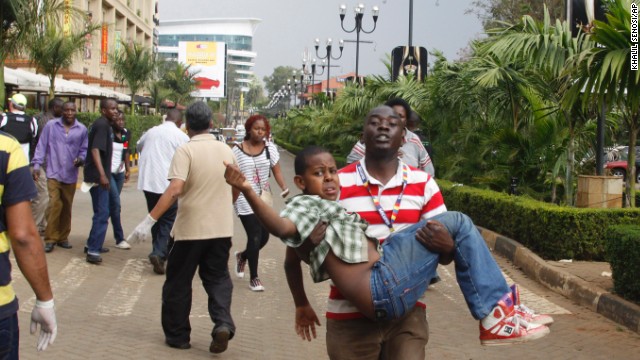 A rescue worker helps a child outside the mall.
A rescue worker helps a child outside the mall.  People who had been hiding inside the mall during the gunfire flee the scene.
People who had been hiding inside the mall during the gunfire flee the scene.  An armed official takes a shooting position inside the mall.
An armed official takes a shooting position inside the mall.  An armed official crouches on September 21.
An armed official crouches on September 21. 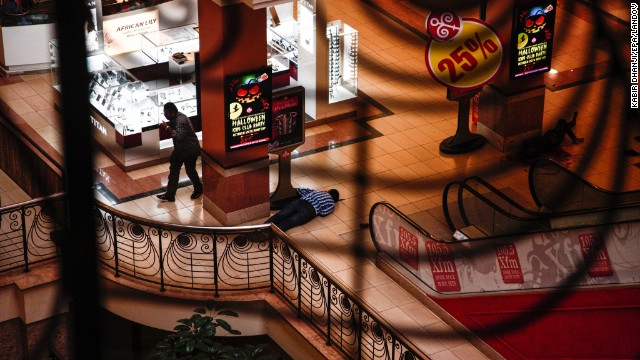 Bodies lie on the ground inside the mall.
Bodies lie on the ground inside the mall. 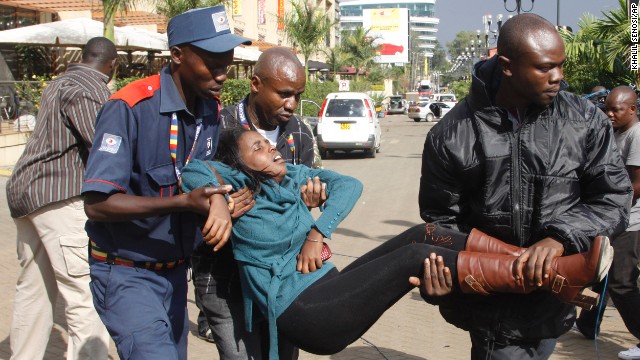 Men help a wounded woman outside the mall.
Men help a wounded woman outside the mall. 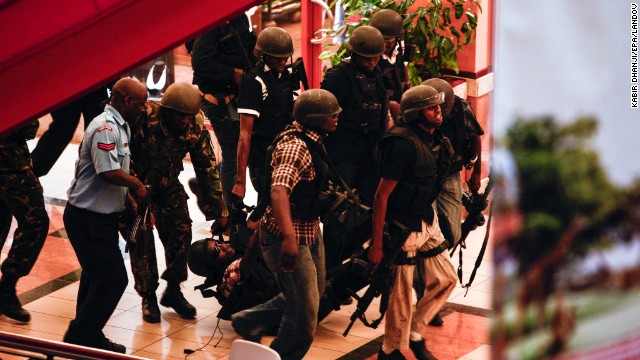 Officials carry an injured man in the mall.
Officials carry an injured man in the mall. 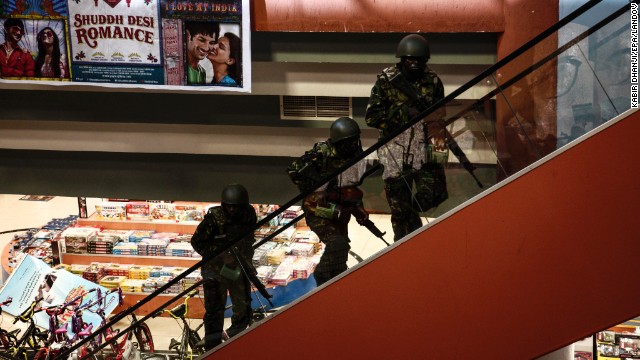 Soldiers move up stairs inside the Westgate Mall.
Soldiers move up stairs inside the Westgate Mall. 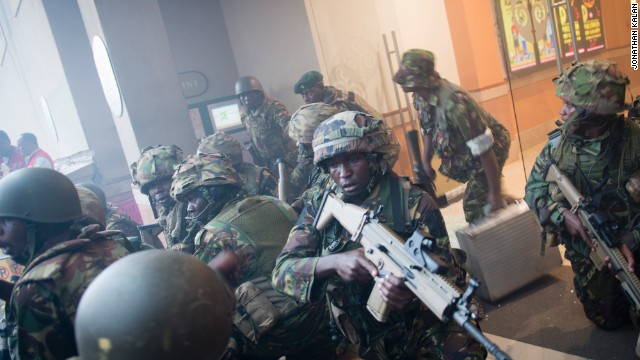 Armed police leave after entering the mall. At least one suspect has been killed, a government official said. Police have said another suspected gunman has been detained at a Nairobi hospital.
Armed police leave after entering the mall. At least one suspect has been killed, a government official said. Police have said another suspected gunman has been detained at a Nairobi hospital.  Armed police take cover behind escalators as smoke fills the air. Witnesses say tear gas was thrown in the corridors.
Armed police take cover behind escalators as smoke fills the air. Witnesses say tear gas was thrown in the corridors.  A woman who had been hiding during the attack runs for cover after armed police enter the mall.
A woman who had been hiding during the attack runs for cover after armed police enter the mall.  A body is seen on the floor inside the smoke-filled four-story mall.
A body is seen on the floor inside the smoke-filled four-story mall.  An injured person is helped on arrival at the Aga Khan Hospital in Nairobi after the attack at the upscale mall.
An injured person is helped on arrival at the Aga Khan Hospital in Nairobi after the attack at the upscale mall. 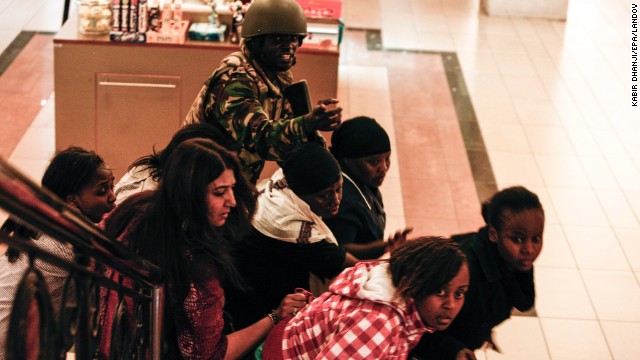 A soldier directs people up a stairway inside the Westgate on September 21.
A soldier directs people up a stairway inside the Westgate on September 21.  An injured man is wheeled into the Aga Khan Hospital in Nairobi.
An injured man is wheeled into the Aga Khan Hospital in Nairobi.  People run from the Westgate Mall.
People run from the Westgate Mall. 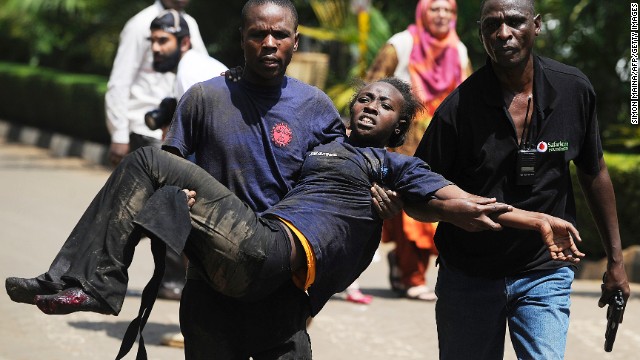 A Kenyan woman is helped to safety after the masked gunmen stormed the upscale mall and sprayed gunfire on shoppers and staff.
A Kenyan woman is helped to safety after the masked gunmen stormed the upscale mall and sprayed gunfire on shoppers and staff. 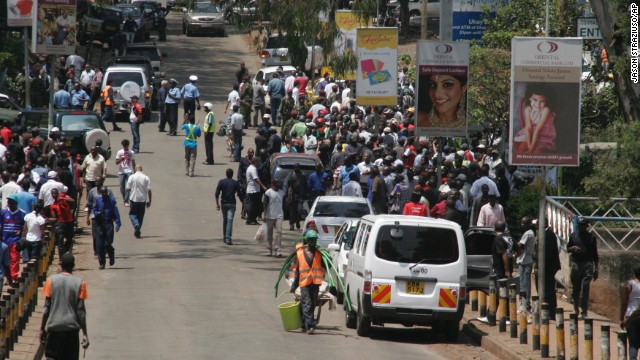 Crowds gather outside the upscale shopping mall. The interior ministry urges Kenyans to keep off the roads near the mall so police can ensure everyone inside has been evacuated to safety.
Crowds gather outside the upscale shopping mall. The interior ministry urges Kenyans to keep off the roads near the mall so police can ensure everyone inside has been evacuated to safety. 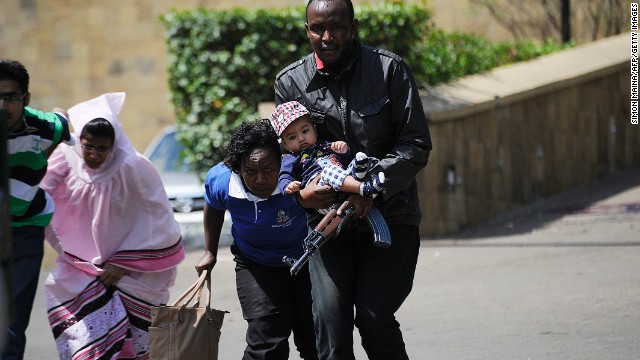 A policeman carries a baby to safety. Authorities said multiple shooters were at the scene.
A policeman carries a baby to safety. Authorities said multiple shooters were at the scene. 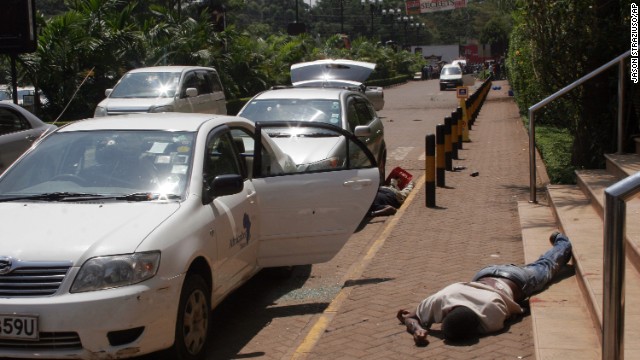 Bodies lie outside the shopping mall.
Bodies lie outside the shopping mall. 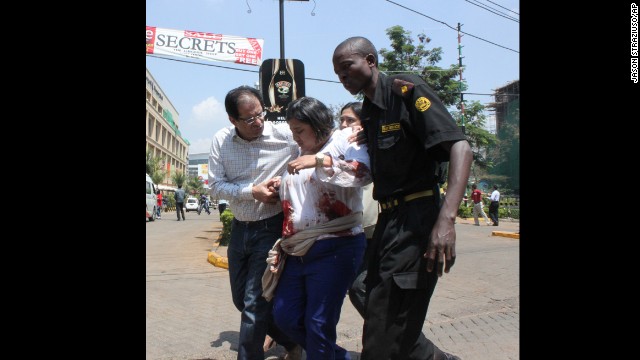 A security officer helps a wounded woman outside.
A security officer helps a wounded woman outside. 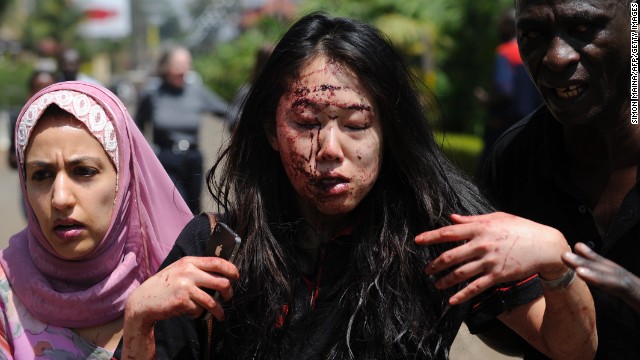 Elaine Dang of San Diego is helped to safety after the attack. The military asked local media not to televise anything live because the gunmen are watching the screens in the mall.
Elaine Dang of San Diego is helped to safety after the attack. The military asked local media not to televise anything live because the gunmen are watching the screens in the mall. 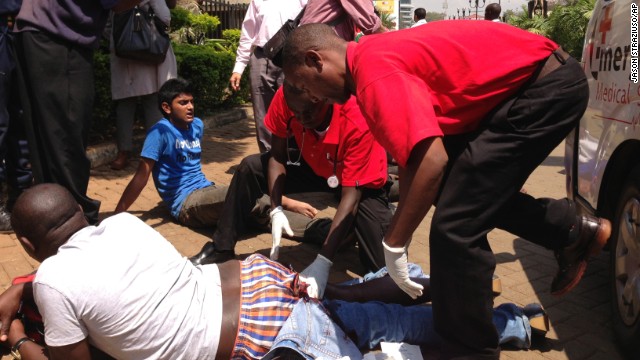 Paramedics treat an injured man outside the mall.
Paramedics treat an injured man outside the mall.  Medical personnel carry a body away.
Medical personnel carry a body away. 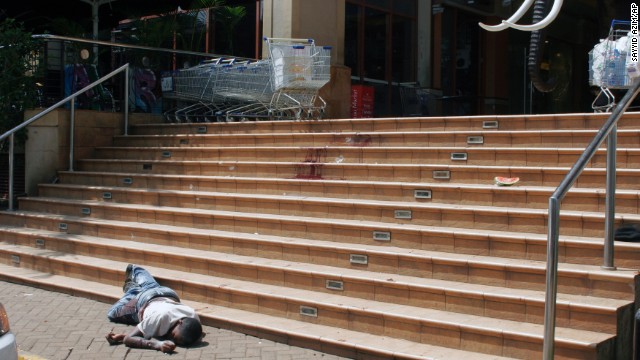 A body lies outside the mall. Gunmen shot people outside the mall as they entered it
A body lies outside the mall. Gunmen shot people outside the mall as they entered it  A woman is pulled by a shopping cart to an ambulance.
A woman is pulled by a shopping cart to an ambulance. 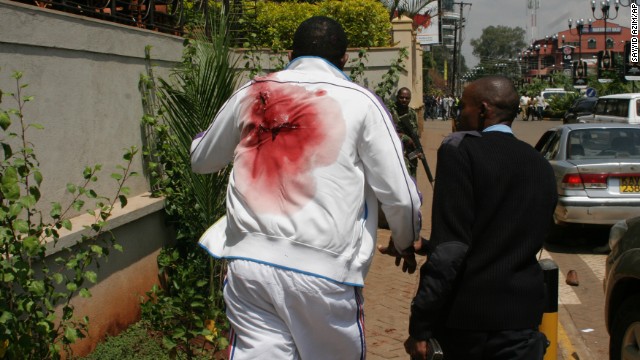 A wounded man is escorted outside the mall.
A wounded man is escorted outside the mall. 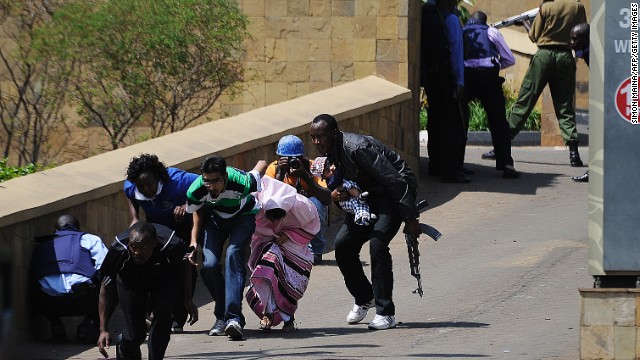 A police officer carries a baby as people keep low and run to safety. Crowds dashed down the streets as soldiers in military fatigues, guns cocked, crawled under cars to get closer to the mall.
A police officer carries a baby as people keep low and run to safety. Crowds dashed down the streets as soldiers in military fatigues, guns cocked, crawled under cars to get closer to the mall. 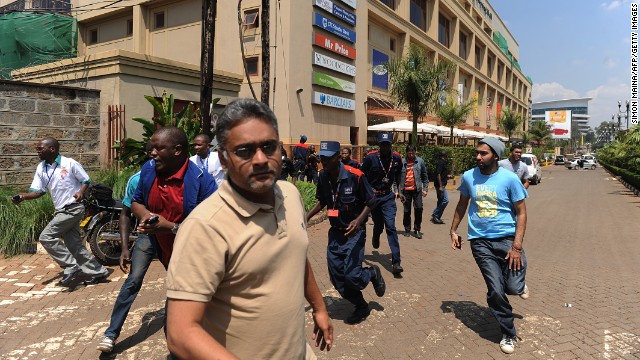 People run away from the scene.
People run away from the scene. 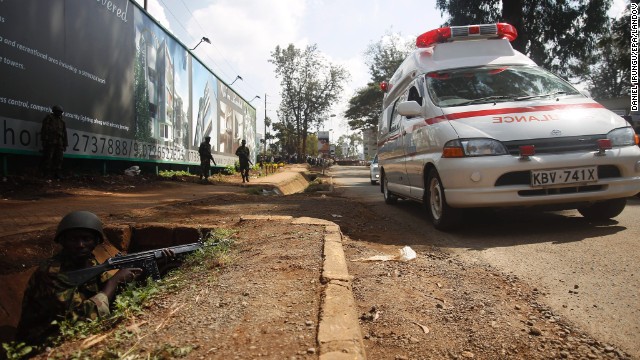 Armed Kenyan forces take position to secure the area around the shopping mall as ambulances move in to carry the injured.
Armed Kenyan forces take position to secure the area around the shopping mall as ambulances move in to carry the injured. 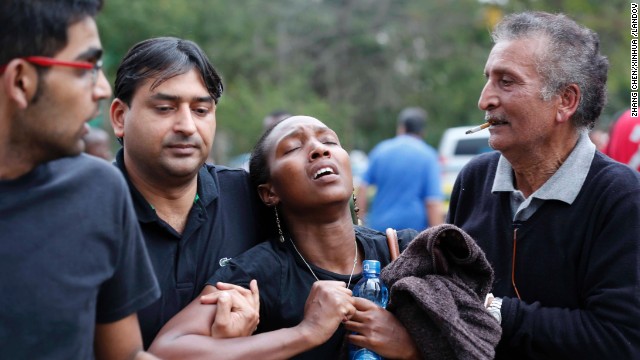 A woman reacts after she is rescued from the mall.
A woman reacts after she is rescued from the mall. 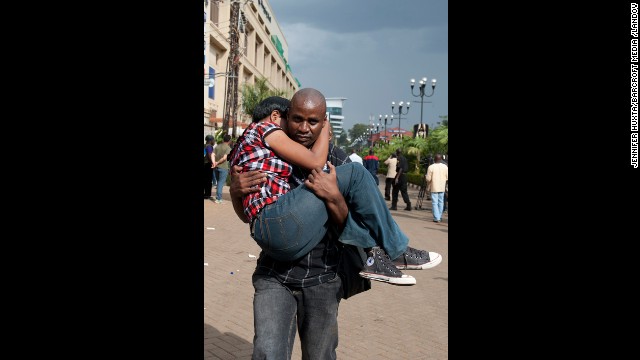 A couple flee the area. As night fell, authorities said they had cornered the gunmen in the mall.
A couple flee the area. As night fell, authorities said they had cornered the gunmen in the mall. Kenya mall attack
Kenya mall attack
Kenya mall attack
Kenya mall attack
Kenya mall attack
Kenya mall attack
Kenya mall attack
Kenya mall attack
Kenya mall attack
Kenya mall attack
Kenya mall attack
Kenya mall attack
Kenya mall attack
Kenya mall attack
Kenya mall attack
Kenya mall attack
Kenya mall attack
Kenya mall attack
Kenya mall attack
Kenya mall attack
Kenya mall attack
Kenya mall attack
Kenya mall attack
Kenya mall attack
Kenya mall attack
Kenya mall attack
Kenya mall attack
Kenya mall attack
Kenya mall attack
Kenya mall attack
Kenya mall attack
Kenya mall attack
Kenya mall attack
Kenya mall attack
Kenya mall attack
Kenya mall attack
Kenya mall attack
Kenya mall attack
Kenya mall attack
Kenya mall attack
Kenya mall attack
Kenya mall attack
Kenya mall attack
Kenya mall attack
Kenya mall attack
Kenya mall attack
Kenya mall attack
Kenya mall attack
Kenya mall attack
Kenya mall attack
Kenya mall attack
STORY HIGHLIGHTS
- The Somali group Al-Shabaab attacked a mall and other targets in Kenya, killing many
- Ethan Mesquita: These terrorist attacks are a sign the rebels are losing
- He says the goal of Al-Shabaab is to rule Somalia, so why would it attack Kenya?
- Mesquita: Terrorism is a weapon of the weak; Al-Shabaab is fighting for its survival
Editor’s note: Ethan Bueno de Mesquita is a professor at the Harris School of Public Policy Studies at the University of Chicago.
(CNN) — The attack by al Qaeda’s Somali affiliate group Al-Shabaab that killed scores at the Westgate mall in Nairobi, Kenya, was horrifying. It was followed by two smaller scale attacks by the group that killed and injured both police and civilians.
Previously, a multilateral campaign against Al-Shabaab undertaken by United Nation’s sanctioned African Union forces, including many from the Kenyan military, was being touted as a great counterinsurgency success story, both for the African Union and the United States. Indeed, the Obama administration directly backed the African Union forces, participated in the counterinsurgency with targeted drone and air strikes and recently formally recognized the new Somali government.
Beginning in 2011, the counterinsurgents pushed Al-Shabaab out of Somalia’s capital, Mogadishu, and made it nearly impossible for Al-Shabaab to hold territory even in its former strongholds in southern Somalia. This was a stunning turnaround for parts of Somalia.

Ethan Bueno de Mesquita
Despite these major counterinsurgent victories, many analysts interpret the recent attacks as a sign of a resurgent Al-Shabaab. The New York Times, for instance, reports that according to senior American counterterrorism and diplomatic officials the attack shows the Somali militants are as dangerous as ever. If Al-Shabaab, with its increasing ties to global jihadi groups, is capable of such spectacular attacks, the argument goes, it is stronger than we thought. Victory was declared too soon.
Nothing could be further from the truth.
The goal of Al-Shabaab is to rule Somalia. In order to do so, it must hold territory. By holding territory rebel groups establish political control, build operational capacity and gain recruits.
Terrorism is a tactic used to spread fear. It is not a tactic suited to holding territory. So, in analyzing the attack in Kenya, one must ask why Al-Shabaab has resorted to a tactic so ill-suited to its goals.
 How terror group recruits in the U.S.
How terror group recruits in the U.S.
 Are we seeing a ‘new’ Al-Shabaab?
Are we seeing a ‘new’ Al-Shabaab?
The answer is that terrorist and other unconventional attacks are now all that Al-Shabaab can manage, precisely because of the success of the counterinsurgent campaign against it.
Terrorism is a weapon of the weak. Rebel groups turn to terrorism when they lack the human and material resources required to field a fighting force capable of using conventional tactics that might actually take and hold territory. That is, terrorist attacks are a sign that rebels are losing — not winning.
This is a pattern that has been seen repeatedly throughout the history of counterinsurgency. Brutal but effective Russian counterinsurgency efforts in the second Chechen war degraded Chechen rebels’ public support and operational capacity. In response, those rebels shifted tactics, resulting in dramatic terrorist attacks in the Moscow Metro in 2010. Those attacks, though deadly, were a sign of a Chechen rebellion no longer able to seriously challenge Russian counterinsurgents.
After the Tet offensive during the Vietnam War, when American and South Vietnamese operations rested local control over a village, mobilization for the North Vietnamese declined in those villages and, as a result, conventional attacks by the North Vietnamese decreased and unconventional attacks by the Viet Cong increased.
The rise of the Irish Republican Army as a terrorist organization can be largely attributed to similar dynamics. After its defeat in the civil war of the early 1920s, the remaining IRA rebels, unable to field a conventional fighting force capable of conventional operations against British and Free State forces, turned to terrorist tactics and assassinations.
Counterinsurgency is a strategically complex business. Rebels shift tactics and strategies in response to changes to their operational environment. Consequently, it is a mistake to expect that every counterinsurgent victory will be followed by a reduction in all forms of violence.
We must learn to recognize when an uptick in violence is really a sign of resurgence and when it is a sign of a rebel group on its heels, fighting for survival. Terrorist attacks by groups like Al-Shabaab that used to control large amounts of territory are an instance of the latter phenomenon. No rebel group loses quietly. But governments must show resolve in the face of attacks, which should be understood for what they are—a sign the counterinsurgents are winning.
Follow us on Twitter @CNNOpinion
Join us on Facebook/CNNOpinion
The opinions expressed in this commentary are solely those of Ethan Bueno de Mesquita.

 How terror group recruits in the U.S.
How terror group recruits in the U.S.  Are we seeing a ‘new’ Al-Shabaab?
Are we seeing a ‘new’ Al-Shabaab?  Relatives of Johnny Mutinda Musango, 48, weep after identifying his body at the city morgue in Nairobi, Kenya, on Tuesday, September 24. Musango was one of the victims of the Westgate Mall hostage siege. Kenyan security forces were still combing the mall on the fourth day of the siege by al Qaeda-linked terrorists.
Relatives of Johnny Mutinda Musango, 48, weep after identifying his body at the city morgue in Nairobi, Kenya, on Tuesday, September 24. Musango was one of the victims of the Westgate Mall hostage siege. Kenyan security forces were still combing the mall on the fourth day of the siege by al Qaeda-linked terrorists.  Ann Gakii reacts at the Nairobi City Mortuary after identifying the body of her father, who was killed in the mall attack on Saturday.
Ann Gakii reacts at the Nairobi City Mortuary after identifying the body of her father, who was killed in the mall attack on Saturday.  A Kenyan soldier runs through a corridor on an upper floor at the Westgate Shopping Mall in Nairobi, Kenya, on September 24, shortly before an explosion was heard. Sounds of heavy gunfire erupted from the mall Tuesday, even as authorities said they had the building under their control. But four days after Al-Shabaab terrorists stormed the swanky mall, several gunmen — including snipers — were still inside, two senior officials said.
A Kenyan soldier runs through a corridor on an upper floor at the Westgate Shopping Mall in Nairobi, Kenya, on September 24, shortly before an explosion was heard. Sounds of heavy gunfire erupted from the mall Tuesday, even as authorities said they had the building under their control. But four days after Al-Shabaab terrorists stormed the swanky mall, several gunmen — including snipers — were still inside, two senior officials said.  Kenyan Defense Forces walk near the mall on Monday, September 23.
Kenyan Defense Forces walk near the mall on Monday, September 23.  Kenyan Defense Forces leave the mall on September 23.
Kenyan Defense Forces leave the mall on September 23.  Stephen, center, is comforted by relatives as he waits for the post mortem exam of his father, who was killed in Saturday’s attack at the mall.
Stephen, center, is comforted by relatives as he waits for the post mortem exam of his father, who was killed in Saturday’s attack at the mall.  A Kenyan police officer guards the entrance of a building near the mall on September 23.
A Kenyan police officer guards the entrance of a building near the mall on September 23.  A Kenyan security officer takes cover as gunfire and explosions are heard from the mall on September 23.
A Kenyan security officer takes cover as gunfire and explosions are heard from the mall on September 23.  Heavy smoke rises from the Westgate Shopping Mall on September 23.
Heavy smoke rises from the Westgate Shopping Mall on September 23.  Medics take cover behind a tree as gunfire and explosions are heard from the Westgate Mall on September 23.
Medics take cover behind a tree as gunfire and explosions are heard from the Westgate Mall on September 23.  A Kenyan police security officer runs for cover as heavy smoke rises from the mall on September 23.
A Kenyan police security officer runs for cover as heavy smoke rises from the mall on September 23.  A paramedic runs for cover outside the mall on September 23.
A paramedic runs for cover outside the mall on September 23.  People run for cover outside the mall after heavy shooting started on September 23.
People run for cover outside the mall after heavy shooting started on September 23.  Kenyan security forces crouch behind a wall outside the mall on September 23.
Kenyan security forces crouch behind a wall outside the mall on September 23.  Soldiers take cover after gunfire near the mall on September 23.
Soldiers take cover after gunfire near the mall on September 23.  Kenyan paramilitary police officers patrol the area near the mall on Sunday, September 22.
Kenyan paramilitary police officers patrol the area near the mall on Sunday, September 22.  Soldiers from the Kenya Defense Forces arrive outside the Westgate Mall on September 22.
Soldiers from the Kenya Defense Forces arrive outside the Westgate Mall on September 22.  A woman shields a baby as a soldier stands guard inside the Westgate Mall on Saturday, September 21.
A woman shields a baby as a soldier stands guard inside the Westgate Mall on Saturday, September 21.  A rescue worker helps a child outside the mall.
A rescue worker helps a child outside the mall.  People who had been hiding inside the mall during the gunfire flee the scene.
People who had been hiding inside the mall during the gunfire flee the scene.  An armed official takes a shooting position inside the mall.
An armed official takes a shooting position inside the mall.  An armed official crouches on September 21.
An armed official crouches on September 21. 
 Bodies lie on the ground inside the mall.
Bodies lie on the ground inside the mall.  Men help a wounded woman outside the mall.
Men help a wounded woman outside the mall.  Officials carry an injured man in the mall.
Officials carry an injured man in the mall.  Soldiers move up stairs inside the Westgate Mall.
Soldiers move up stairs inside the Westgate Mall.  Armed police leave after entering the mall. At least one suspect has been killed, a government official said. Police have said another suspected gunman has been detained at a Nairobi hospital.
Armed police leave after entering the mall. At least one suspect has been killed, a government official said. Police have said another suspected gunman has been detained at a Nairobi hospital.  Armed police take cover behind escalators as smoke fills the air. Witnesses say tear gas was thrown in the corridors.
Armed police take cover behind escalators as smoke fills the air. Witnesses say tear gas was thrown in the corridors.  A woman who had been hiding during the attack runs for cover after armed police enter the mall.
A woman who had been hiding during the attack runs for cover after armed police enter the mall.  A body is seen on the floor inside the smoke-filled four-story mall.
A body is seen on the floor inside the smoke-filled four-story mall.  An injured person is helped on arrival at the Aga Khan Hospital in Nairobi after the attack at the upscale mall.
An injured person is helped on arrival at the Aga Khan Hospital in Nairobi after the attack at the upscale mall.  A soldier directs people up a stairway inside the Westgate on September 21.
A soldier directs people up a stairway inside the Westgate on September 21.  An injured man is wheeled into the Aga Khan Hospital in Nairobi.
An injured man is wheeled into the Aga Khan Hospital in Nairobi.  People run from the Westgate Mall.
People run from the Westgate Mall.  A Kenyan woman is helped to safety after the masked gunmen stormed the upscale mall and sprayed gunfire on shoppers and staff.
A Kenyan woman is helped to safety after the masked gunmen stormed the upscale mall and sprayed gunfire on shoppers and staff.  Crowds gather outside the upscale shopping mall. The interior ministry urges Kenyans to keep off the roads near the mall so police can ensure everyone inside has been evacuated to safety.
Crowds gather outside the upscale shopping mall. The interior ministry urges Kenyans to keep off the roads near the mall so police can ensure everyone inside has been evacuated to safety.  A policeman carries a baby to safety. Authorities said multiple shooters were at the scene.
A policeman carries a baby to safety. Authorities said multiple shooters were at the scene.  Bodies lie outside the shopping mall.
Bodies lie outside the shopping mall.  A security officer helps a wounded woman outside.
A security officer helps a wounded woman outside.  Elaine Dang of San Diego is helped to safety after the attack. The military asked local media not to televise anything live because the gunmen are watching the screens in the mall.
Elaine Dang of San Diego is helped to safety after the attack. The military asked local media not to televise anything live because the gunmen are watching the screens in the mall.  Paramedics treat an injured man outside the mall.
Paramedics treat an injured man outside the mall.  Medical personnel carry a body away.
Medical personnel carry a body away.  A body lies outside the mall. Gunmen shot people outside the mall as they entered it
A body lies outside the mall. Gunmen shot people outside the mall as they entered it  A woman is pulled by a shopping cart to an ambulance.
A woman is pulled by a shopping cart to an ambulance.  A wounded man is escorted outside the mall.
A wounded man is escorted outside the mall.  A police officer carries a baby as people keep low and run to safety. Crowds dashed down the streets as soldiers in military fatigues, guns cocked, crawled under cars to get closer to the mall.
A police officer carries a baby as people keep low and run to safety. Crowds dashed down the streets as soldiers in military fatigues, guns cocked, crawled under cars to get closer to the mall.  People run away from the scene.
People run away from the scene.  Armed Kenyan forces take position to secure the area around the shopping mall as ambulances move in to carry the injured.
Armed Kenyan forces take position to secure the area around the shopping mall as ambulances move in to carry the injured.  A woman reacts after she is rescued from the mall.
A woman reacts after she is rescued from the mall.  A couple flee the area. As night fell, authorities said they had cornered the gunmen in the mall.
A couple flee the area. As night fell, authorities said they had cornered the gunmen in the mall. 


















































No comments:
Post a Comment